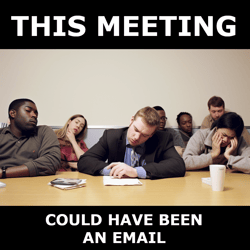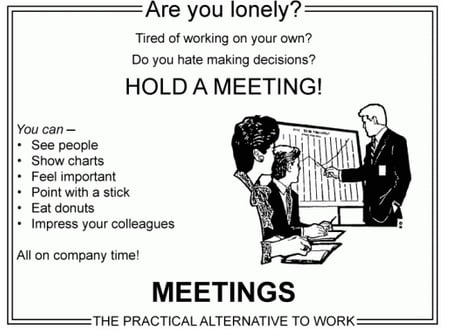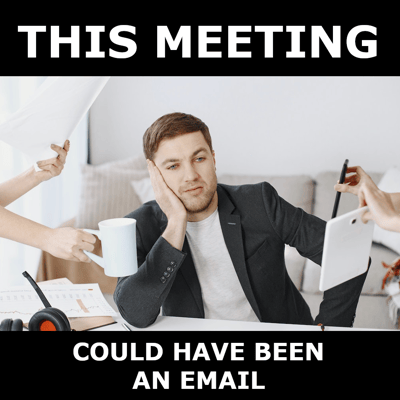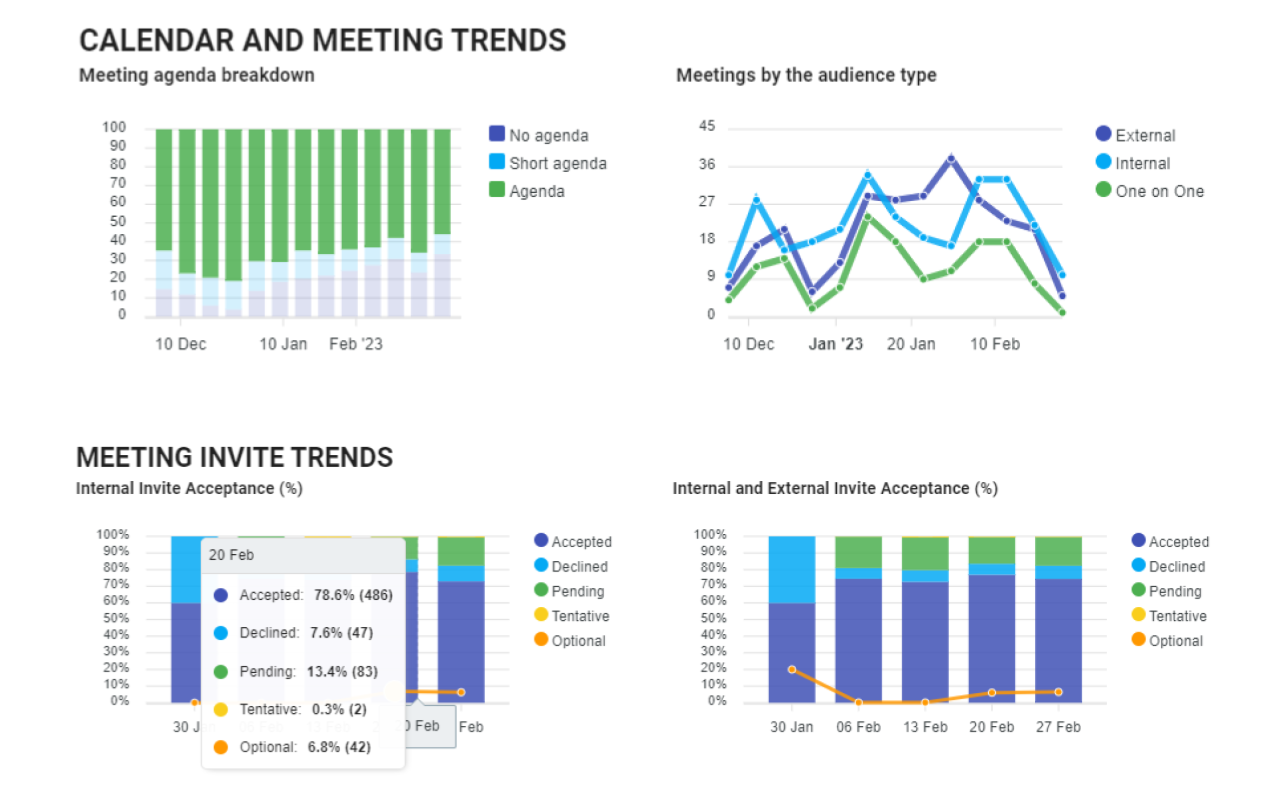If you've ever found yourself sitting in a meeting, mindlessly nodding along as the discussion drones on, you've likely had this thought: "This meeting could have been an email"? You're not alone. This sentiment has been immortalized in a meme that's been shared, liked, and chuckled over by office workers worldwide.
This Meeting Could Have Been an Email: The Meme Unpacked
The meme "This meeting could have been an email" is a cheeky nod to a universal workplace frustration. The joke practically writes itself: an image of a bored office worker, a cartoon character facepalming, or a comically long meeting table, all slapped with the text "This meeting could have been an email." It's funny because it's true, right?
The meme typically takes the form of a humorous image or a short phrase, often paired with a wry caption. It's shared on social media platforms, in group chats, or even subtly referenced in the comments section of a particularly tedious online meeting. The meme serves as a light-hearted yet pointed critique of meetings that seem to serve little purpose other than to fill up calendars and drain employees' time and energy.

The scenarios depicted in these memes are all too familiar to many professionals. Picture this: a group of employees, their eyes glazed over, sit around a conference table while a manager drones on about something that could have been succinctly communicated in an email. Or imagine an employee, their frustration palpable, staring at their computer screen during a meeting that's dragging on, thinking, "This could have been an email."
The beauty of this meme is in its relatability.
It's a shared experience that transcends industries and job titles. Whether you're a junior employee or a senior executive, chances are you've found yourself in a meeting that could have easily been an email. This meme taps into that shared frustration, offering a humorous outlet for a common workplace grievance.
 But while the meme is undoubtedly funny, it also underscores a serious issue in many workplaces: the misuse and overuse of meetings. Meetings, when used effectively, can be a powerful tool for collaboration and decision-making. However, when they're used as a default communication method or a way to fill time, they can become a drain on productivity and a source of frustration for employees.
But while the meme is undoubtedly funny, it also underscores a serious issue in many workplaces: the misuse and overuse of meetings. Meetings, when used effectively, can be a powerful tool for collaboration and decision-making. However, when they're used as a default communication method or a way to fill time, they can become a drain on productivity and a source of frustration for employees.
So, while we might laugh at the "This meeting could have been an email" meme, it's also a call to action. It's a reminder to consider whether a meeting is truly the best way to communicate information or if there might be a more efficient method. It's a prompt to reassess our meeting culture and look for ways to make it more effective and respectful of everyone's time. Because at the end of the day, no one wants their workday to become a, well, meme.
The Reality of Workplace Meetings
We've all been there - the meeting that drags on, the discussion that veers off-topic, the sense that we're just going through the motions. It's a universal experience, which probably also got YOU into reading this article. But it's also a serious issue that impacts our productivity and job satisfaction.

According to a survey by Harvard Business Review, 65% of senior managers said meetings keep them from completing their own work. That's a significant chunk of time that could be spent on other tasks. And it's not just about the time wasted - it's also about the mental toll. When we're stuck in unproductive meetings, it can leave us feeling frustrated and disengaged.

But let's not just focus on the negatives. Meetings, when done right, can be a powerful tool for collaboration and decision-making. They can bring teams closer together, foster innovation, and drive progress. The key is to make sure they're used effectively.
Remember the feeling when a meeting ends with a clear action plan, everyone's on the same page, and you're excited to get started? That's the power of a good meeting. And it's something we should strive for in every gathering we attend or lead.

In the end, it's about finding the right balance. Yes, some meetings could probably be an email. But others are crucial for our work. The challenge is to distinguish between the two and make the most of the time we spend together. After all, we're not just coworkers - we're a team. And teams need to communicate, collaborate, and connect. That's the reality of workplace meetings.
So What Can We Do About It?
How can you bring up this issue without causing conflict or appearing unprofessional? The answer lies in open, honest communication. And as always it helps if you also have facts to back your message. But let's be real, it's not always smooth sailing. So, here are a few things that you might want to consider.
1. Yes. This is frustrating.
Frustration is a natural response to situations where you feel your time isn't being valued or used effectively. It's not just about the meetings; it's about what you could be accomplishing during that time. It's about the deadlines that loom closer with each passing minute, the tasks piling up in your inbox, and the feeling of being stuck in a cycle of unproductive meetings.
2. Identify the Issue(s)
Once you've acknowledged your frustration, the next step is to identify the specific issues causing it. Is it the frequency of the meetings? The lack of a clear agenda? The tendency for discussions to go off-topic? Using meeting analytics tool like Flowtrace you can immediately see what are the most important pain points in your meeting culture and how to start solving them. By pinpointing the root cause, you can address the problem more effectively.
3. Start the Conversation
Now comes the challenging part: starting the conversation. It's crucial to approach this with a calm and professional demeanor. Express your concerns honestly, but remember to focus on the issue at hand, not the individuals involved. Use phrases like "I feel" or "I've noticed" to express your feelings without blaming others.
Once more, leveraging data to support your discussion can prove invaluable. By presenting concrete evidence from your meeting analytics tool, you can clearly illustrate the root causes of the frustration. This approach facilitates a shared understanding of the critical issues that need to be addressed.

4. Propose Solutions
Discussing the problem is a good start, but proposing solutions shows initiative and a willingness to contribute to improving the situation. Perhaps you could suggest a time limit for meetings, or the implementation of a clear agenda distributed before each meeting. You could also recommend alternative communication methods for less urgent or complex topics, such as email or team collaboration tools.
Here are 16 tips how to make your meetings more effective.
Using Meeting Analytics to Your Advantage
Meeting analytics can be a powerful tool in not only turning unnecessary meetings into emails, but also improving the quality of the crucial ones. Flowtrace, a leading provider of meeting analytics solutions, will make this easy for you.

Using Flowtrace you will immediately identify patterns and trends that may be contributing to meeting overload. For example, you might find that certain times of day or days of the week are particularly meeting-heavy. Or, you might discover that certain individuals or teams are more likely to schedule unnecessary meetings. Using this information, you can make data-driven decisions and propose targeted solutions to improve meeting efficiency.
Setting up Flowtrace takes less than 5 minutes - and you can get started for free!

Stop Wasting Time in Meetings
The next time you're about to schedule a meeting, consider whether it could be more effectively handled through an email or another form of communication. Not only will this save time, but it could also boost productivity and morale in the workplace.
Remember, the goal is not to eliminate meetings entirely, but to ensure that they are used effectively and judiciously. After all, some discussions and decisions are best made in a collaborative, face-to-face (or screen-to-screen) setting. But for everything else, perhaps that meeting could indeed have been an email.